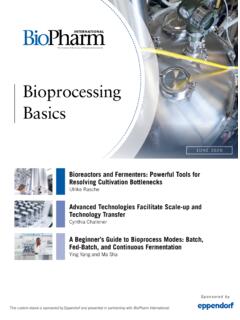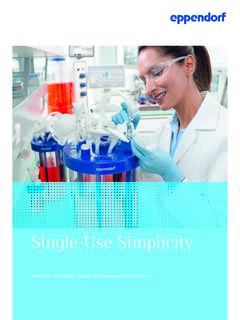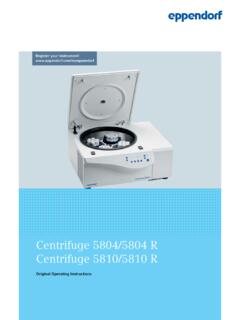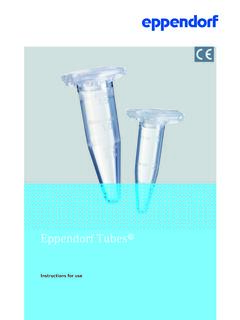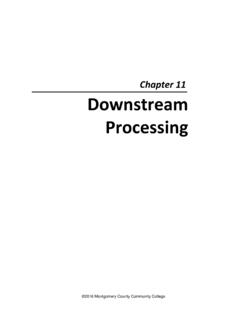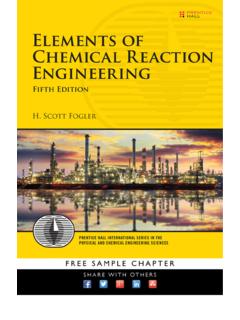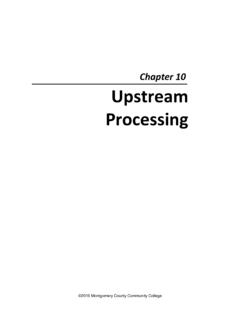Transcription of A Beginner’s Guide to Bioprocess Modes – Batch, Fed- Batch ...
1 A Beginner s Guide to Bioprocess Modes Batch , Fed- Batch , and Continuous FermentationYing Yang and Ma ShaEppendorf Inc., Enfield, CT, USAC ontact: NOTE No. 408 AbstractIn this application note, we explain the differences between Batch , fed- Batch , and continuous fermentation and how these influence culture growth. As an example, we look at E. coli fermentation processes at bench scale. We track the biomass and nutrient concentrations during Batch , fed- Batch , and continuous fermentation runs. We explain different methods to analyze the process, including determination of biomass, growth rate, productivity, yield, and analysis of process costs. The comparisons can help Bioprocess engineers to select the most appropriate method to meet their needs. In our examples we studied E.
2 Coli fermentation at bench scale. The principles may also apply to bioprocesses using other microbes or mammalian cells, at both smaller and larger microorganisms consume carbon sources, mainly sugar, to produce various acids, alcohols, and gases. In industry, fermentation is used to produce biopharmaceuticals, food and feed supplements, biofuels, and chemical building blocks. To establish a cost-effective process, Bioprocess engineers have to consider various factors, including the costs for media and supplements, the process runtime, bacterial growth and viability, product titer and yield, and product quality. The concentrations of nutrients and by-products in the culture medium are important influencing factors. This is why, during process development, Bioprocess engineers decide whether to apply a Batch , fed- Batch or continuous Batch fermentation, microorganisms are inoculated to a fixed volume of medium in a fermentor.
3 With microbial growth, the nutrients are gradually consumed and by-products accumulate. Therefore the culture environment is continuously changing. The broth is removed at the end of the run. The growth curve is usually divided into distinct phases. During the initial lag phase, growth is slow, as the organism needs to adapt to the new environment. During the exponential growth phase, the microbes divide at a constant rate. When nutrients are getting depleted and by-products accumulate, growth slows down, and the culture enters the stationary growth phase. At this point, Bioprocess engineers usually harvest the culture. If the culture continues, it would finally enter the death phase, which is characterized by a decrease in the viable cell density. The advantages of Batch processing are ease of operation and low risk of contamination.
4 Disadvantages are the comparatively low cell densities which can be achieved and the relatively long downtime between batches, due to cleaning, vessel setup, and sterilization. Batch fermentation is a convenient starting point for beginners in this field, and APPLICATION NOTE I No. 408 I Page 2is often used to optimize conditions in the early stages of experimental fermentation is a modified version of Batch fermentation. It is the most common mode of operation in the Bioprocess industry. Microorganisms are inoculated and grown under Batch regime for a certain amount of time, then nutrients are added to the fermenter in increments throughout the remaining duration of fermentation to feed them. The entire culture suspension is removed at the end of each run. The start of feeding is normally determined by substrate limitation in the broth, and the time profile of feeding should be designed in a way that the substrate remains non-excessive while microbial growth is fully supported.
5 Because of the addition of fresh nutrients, extensive biomass accumulation normally occurs in the exponential growth phase. Therefore, fed- Batch fermentation is very useful for bioprocesses aiming for high biomass density or high product yield when the desired product is positively correlated with microbial growth. Also, because the substrate is not overfed during the process, by-product accumulation is continuous fermentation, fresh medium is continuously added to the fermentor, while used medium and cells are harvested at the same time. Consumed nutrients are replaced and toxic metabolites are removed from the culture. When addition and removal are at the same rate, the culture volume stays constant. Therefore, in contrast to fed- Batch fermentation, the maximum working volume of the vessel does not limit the amount of fresh medium or feed solution which can be added to the culture in the course of the process.
6 Keeping the working volume constant furthermore simplifies culture scale-up based on constant-power-to-volume strategy [1]. The rate of medium exchange can be optimized to reach a steady state. In steady state, the cellular growth rate and environmental conditions, like the concentrations of metabolites, stay constant. Cultures in steady-state can last for days, weeks or even months, thus greatly reducing the downtime and making the process more economically competitive. Due to the long cultivation, sterility maintenance can be challenging, and downstream processing is complicated [2].For this application note, we cultured E. coli in Eppendorf BioBLU 3f Single-Use Vessels and directly compared these three Modes of fermentation and MethodsBacterial strainThe bacterial strain used in this study was E.
7 Coli ATCC 25922 GFP . A mini cell bank was prepared from the cryovial obtained from ATCC, as described previously [2]. This strain has an ampicillin resistance gene (bla) encoded on a plasmid. A concentration of g/L ampicillin must be maintained in all cultures, since absence or low concentrations of ampicillin will result in plasmid loss [3]. Therefore, from inoculum preparation in shake flasks to fermentation runs in 3 L vessels, we always added g/L ampicillin to the medium. Media preparationWe prepared different types of media for various purposes in this study. All chemicals were purchased from Sigma Aldrich , USA unless mentioned carried out two different types of Batch fermentation, one in complex medium and one in chemically definded medium. The medium recipe was the only difference between these two Batch fermentations.
8 The complex medium was a water solution containing g/L Terrific Broth Modified (Thermo Fisher Scientific , USA), % (v/v) glycerol, and % (v/v) Antifoam 204 which is a mixture of organic polyether dispersions. The detailed composition of each medium is described in the appendix in Table chemically defined medium was prepared as follows. We prepared 10 x citrate-phosphate buffer, 100 x trace element solution, thiamin (vitamin B1) stock solution, and magnesium sulfate stock solution in advance, as described in the appendix in Table A2. For each run, we first filled the vessel with a DI water solution containing citrate-phosphate buffer and antifoam. After autoclave sterilization, we aseptically added MgSO4 stock solution, 100 x trace element solution, and thiamine stock solution to the vessel.
9 Glucose APPLICATION NOTE I No. 408 I Page 3and ampicillin were also aseptically added to reach a final concentration of 90 g/L and g/L, respectively (Table A1).For fed- Batch fermentation, we used chemically defined medium as well, as described in Table A1. We prepared L feeding medium containing MgSO4, thiamine, trace elements, and 614 g/L continuous fermentation, the preparation of chemically defined medium was almost the same as for fed- Batch fermentation except the volume for citrate-phosphate buffer and the original total volume to start with (Table A1). The L feeding medium were prepared the same way as for the fed- Batch fermentation (Table A1). Table 1 summarizes the media prepared for each operational preparationFor inoculum preparation, g Terrific Broth Modified and mL glycerol were dissolved in DI water to make a total volume of 300 mL, and sterilized through autoclaving.
10 After cooling to room temperature, we transferred 150 mL of the medium and added 3 mL of the m membrane filtration-sterilized 50 x ampicillin stock solution (5 g/L, Table A2) to each of the two 500 mL sterile Erlenmeyer flasks. We inoculated each flask with 500 L E. coli suspension from a single pre-thawed cryovial from the cell bank. We put the two Erlenmeyer flasks into an Eppendorf Innova S44i incubator shaker, set the temperature at 37 C and agitation at 200 rpm, and left it overnight for inoculum growth. We transferred the entire 150 mL of growing culture from one Erlenmeyer flask to a pre-sterilized bottle, and pumped the E. coli suspension into the vessel to reach an inoculation ratio of 5 % (v/v) for each run. The starting optical density at 600 nm (OD600) was between and We had done a preliminary study to demonstrate that varying the starting biomass density between and OD600 had no significant effect upon harvest in a normal 8+ hour 3 L fermentation run of an overnight E.

